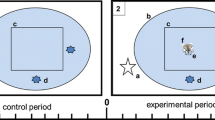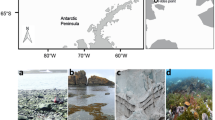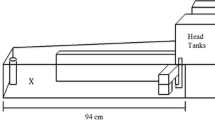Abstract
Marsh hermit crabsPagurus longicarpus Say directly acquire new shells as the predatory gastropodMelongena corona Gmelin consumes marsh periwinkles,Littorina irrorata Say. The influx rate of new shells into a salt marsh hermit crab population was measured by marking live periwinkles and daily recovering the shells from hermit crabs over periods of 3 to 6 d. Average rates of new shell acquisition ranged from 4.0 to 23.3 new shells per day from salt marsh areas of 4×10 m. Such consistently high rates contrast with the negligible rates generally assumed for new shell entry into hermit crab populations. The number of new shells acquired each day varied directly with the number of the predatory gastropod,M. corona, present in each study area at both natural and manipulated predator densities. Empty shells on the substrate are usually considered as the primary source of new shells to hermit crabs. However, over 500 empty shells had to be placed on the substrate in a 4×10 m area to provide a daily rate of 20 new shells to the hermit crab population.
Similar content being viewed by others
Literature cited
Abrams, P.: Resource partitioning and interspecific competition in a tropical hermit crab community. Oecologia46, 365–379 (1980)
Gertness, M.: Competitive dynamics of a tropical hermit crab assemblage. Ecology62, 751–761 (1981)
Brown, B. and M. Hollander. Statistics: a biomedical introduction. New York: J. Wiley and Sons 1977
Childress, J.: Behavioral ecology and fitness theory in a tropical hermit crab. Ecology54, 960–964 (1972)
Fotheringham, N.: Population consequences of shell utilization by hermit crabs. Ecology57, 570–578 (1976)
Gilchrist, S.: A critical view of hermit crab shell use. Florida State University dissertation. 1982
Gilchrist, S. and L. Abele: Estimation of population parameters in hermit crabs. (In review)
Hamilton, P.: Predation onLittorina irrorata (Mollusca; Gastropoda) by Callinectes sapidus (Crustacea: Portunidae). Bull. mar. Sci.26, 403–409 (1976)
Hazlett, B.: Communication and mutual resource exchange in North Florida hermit crabs. Behav. Ecol. Socio.6, 177–184 (1980)
Hazlett, B.: The behavioral ecology of hermit crabs. Annu. Rev. Ecol. Syst.12, 1–22 (1981)
Hazlett, B. and W. Bossert: Additional observations on the communication systems of hermit crabs. Anim. Behav.14, 546–549 (1966)
Kellogg, C.: Gastropod shells: a potentially limiting resource for hermit crabs. J. exp. mar. Biol. Ecol.22, 101–111 (1976)
Kurz, H. and K. Wagner: Tidal marshes of the Gulf and Atlantic coasts of northern Florida and Charleston, South Carolina. Fla State Univ. Stud.24, 1–68 (1957)
Mather, J.: Choice and competition: their effects on occupancy of shell homes byOctopus joubini. Mar. Behav. Physiol.8, 285–293 (1982)
McLean, R.: Direct shell acquisition by hermit crabs from gastropods. Experientia30, 206–208 (1974)
McLean, R.: A description of a marine benthic faunal habitat web: a behavioral study. Florida State University dissertation. 1975
McLean, R.: Gastropod shells: a dynamic resource that helps shape benthic community structure. J. exp. mar. Biol. Ecol.64, 151–174 (1983)
Rebach, S: Burying behavior in relation to substrate and temperature in the hermit crabPagurus longicarpus. Ecology55, 195–198 (1974)
Rittschof, D.: Chemical attraction of hermit crabs and other attendants to simulated gastropod predation sites. J. Chem. Ecol.6, 103–118 (1980a)
Rittschof, D.: Enzymatic production of small molecules attracting hermit crabs to simulated gastropod predation sites. J. Chem. Ecol.6, 665–676 (1980b)
Rutherford, J.: Removal of living snails from their shells by a hermit crab. Veliger19, 438–439 (1977)
Scully, E.: The effects of gastropod shell availability and habitat characteristics on shell utilization by the intertidal hermit crabPagurus longicarpus. J. exp. mar. Biol. Ecol.37, 139–152 (1979)
Scully, E.: The behavioral ecology of competition and resource utilization among hermit crabs.In: Studies in adaptation: the behavior of higher crustacea. Ed. by S. Rebach and D. Dunham, New York: J. Wiley and Sons 1982
Spight, T.: Availability and use of shells by intertidal hermit crabs. Biol. Bull. mar. biol. Lab., Woods Hole152, 120–133 (1977)
Vance, R.: Competition and mechanisms of coexistence in three sympatric species of intertidal hermit crabs. Ecology53, 1062–1074 (1972a)
Vance, R.: The role of shell adequacy in behavioral interactions involving hermit crabs. Ecology53, 1045–1083 (1972b)
Warren, J. Predator avoidance by the salt marsh periwinkleLittorina irrorata (Say). Florida State University thesis. 1982
Wilber, Jr., T. and W. Herrnkind: Rate of new shell acquisition by hermit crabs in a salt marsh habitat. J. Crust. Biol.2, 588–592 (1982)
Author information
Authors and Affiliations
Additional information
Communicated by J.M. Lawrence, Tampa
This is the first in a new contribution series from the Florida State University Marine Laboratory No. 1001
Rights and permissions
About this article
Cite this article
Wilber, T.P., Herrnkind, W.F. Predaceous gastropods regulate new-shell supply to salt marsh hermit crabs. Mar. Biol. 79, 145–150 (1984). https://doi.org/10.1007/BF00951823
Accepted:
Issue Date:
DOI: https://doi.org/10.1007/BF00951823




